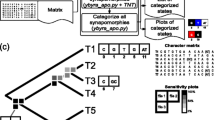Abstract
Choosing and designing primers based on available DNA sequence data and statistical contrasting of domains or structural features is a common routine among molecular biologists. Currently available, free software tools were found to lack desirable features related to these tasks. This was the motivation for developing a new program, SeqState. SeqState locates regions that remain to be sequenced in phylogenetic DNA datasets, evaluates user-provided primers and selects primers best suited to fill gaps in the sequences. If the primers provided by the user are unsuitable, new primers are designed. Primers can be loaded from a primer database, be supplied as part of the alignment or be entered manually. The position of internal primers is automatically localised in the loaded data file. Primers can be edited, and changes and new primers can be saved to the database. Primer sheets allow the user to view internal dimers, complements to a second primer, mismatches to all loaded sequences, and other primer characteristics. Calculation of various sequence statistics can be requested for the whole dataset or parts thereof (character sets), with standard errors estimated by bootstrapping. Insertion-deletion events can be evaluated statistically and encoded for subsequent phylogenetic analysis according to several published coding principles.
Availability: SeqState runs on all major computer platforms and is downloadable for free from http://www.nees.uni-bonn.de/downloads/SeqState, together with documentation and sample data files, or can be requested from the author.


Similar content being viewed by others
References
Soltis DE, Soltis PS, Chase MW, et al. Angiosperm phytogeny inferred from 18S rDNA, rbcL, and atpB sequences. Bot J Linn Soc 2000; 133: 381–461
Hilu KW, Borsch T, Müller K, et al. Angiosperm phytogeny based on matK sequence information. Am J Bot 2003; 90: 1758–76
Fernandes RJ, Skiena SS. Microarray synthesis through multiple-use PCR primer design. Bioinformatics 2002; 18 Suppl. 1: S128–35
Lowe T, Sharefkin J, Yang SQ, et al. A computer program for selection of oligonucleotide primers for PCR. Nucleic Acids Res 1990; 18: 1757–62
Le Novère N. MELTING, computing the melting temperature of nucleic acid duplex. Bioinformatics 2001; 17: 1226–7
Nixon KC. Winclada [computer program]. Available from URL: http://www.cladistics.com/about_winc.htm [Accessed 2005 May 8]
Swofford DL. PAUP*: Phylogenetic Analysis Using Parsimony (and Other Methods) [computer program]. Sunderland (MA): Sinauer Associates, 1998. Available from URL: http://www.sinauer.com/detail.php?id=8060 [Accessed 2005 May 8]
Kumar S, Tamura K, Jakobsen IB, et al. MEGA3: Molecular Evolutionary Genetics Analysis [computer program]. Tempe (AZ): Arizona State University, 2001. Available from URL: http://www.megasoftware.net/index.html [Accessed 2005 May 8]
Maddison DR, Swofford D, Maddison WP. NEXUS: an extensible file format for systematic information. Syst Biol 1997; 46: 590–621
Graham SW, Reeves PA, Burns ACE, et al. Microstructural changes in noncoding chloroplast DNA: interpretation, evolution, and utility of indels and inversions in basal angiosperm phylogenetic inference. Int J Plant Sci 2000 Nov; 161 Suppl. S: S83–96
Simmons MP, Ochoterena H, Carr TG. Incorporation, relative homoplasy, and effect of gap characters in sequence-based phylogenetic analyses. Syst Biol 2001; 50: 454–62
Maddison WP, Maddison DR. MacClade [computer program]. Sunderland (MA): Sinauer Associates, 1992. Available from URL: http://www.macclade.org/macclade.html [Accessed 2005 May 8]
Simmons MP, Ochoterena H. Gaps as characters in sequence-based phylogenetic analyses. Syst Biol 2000; 49: 369–81
Barriel V. Molecular phytogenies and how to code insertion/deletion events. C R Acad Sci III 1994; 317: 693–701
Baum DA, Sytsma KJ, Hoch PC. A phylogenetic analysis of Epilobium (Onagraceae) based on nuclear ribosomal DNA sequences. Syst Bot 1994; 19: 363–88
Bena G, Prosper J-M, Lejeune B, et al. Evolution of annual species of the genus medicago: a molecular phylogenetic approach. Mol Phylogenet Evol 1998; 9: 552–9
Acknowledgements
This work has resulted from the need to frequently design internal primers during studies financed by the Deutsche Forschungsgemeinschaft (DFG), grant number Bo 1815/1 to T. Borsch (DFG project ‘Systematics of Amaranthaceae and evolution of pollen characters’). Many thanks to Professor Barthlott for his constant support and to D. Quandt, C. Löhne, A. Worberg and T. Borsch, as well as to anonymous reviewers, for helpful comments and testing of the program.
The author has no conflicts of interest that are directly relevant to the content of this article.
Author information
Authors and Affiliations
Corresponding author
Rights and permissions
About this article
Cite this article
Müller, K. SeqState. Appl-Bioinformatics 4, 65–69 (2005). https://doi.org/10.2165/00822942-200504010-00008
Published:
Issue Date:
DOI: https://doi.org/10.2165/00822942-200504010-00008




